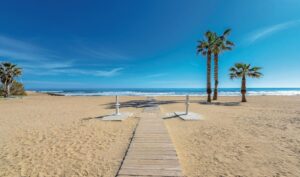Giant Redwood planted in West Ham Park in memory of Her Late Majesty The Queen

A Giant Redwood tree has been planted in West Ham Park as a living memorial to Her Late Majesty Queen Elizabeth II.
Pupils from Park Primary School in Newham helped plant lavender around the tree, which was planted in the park’s Ornamental Gardens, as part of the Queen’s Green Canopy campaign.
The initiative was created to mark The Queen’s Platinum Jubilee in June last year.
Following her passing in September, His Majesty The King agreed to extend the scheme to allow people to plant trees in her memory.
The Redwood is expected to grow to over 50 metres tall and as the tree matures, the branches will spread widely, providing shade and boosting the park’s biodiversity.
West Ham Park is the largest park in the London Borough of Newham and is managed by the City of London Corporation as a registered charity.
The park is listed as a Grade II site. It attracts over 1.3 million visitors every year.
Chair of the City Corporation’s West Ham Park Committee, Caroline Haines, said:
“We are honoured that West Ham Park was chosen as part of this initiative, creating a living memorial to Her Late Majesty The Queen.
“Every tree planted brings so many benefits for people, wildlife, and our climate.
“Her Late Majesty loved the outdoor natural environment and recognised the extraordinary value of open spaces to national health and wellbeing.”
The City Corporation recently invested over £750,000 to transform the park’s playground.
Its centrepiece is an explorer’s ship inspired by the travels of Dr Fothergill, who established a botanical garden on the site which is now West Ham Park.
The City Corporation manages over 11,000 acres of open space in London and southeast England, including West Ham Park and Hampstead Heath, and over 200 smaller sites in the Square Mile, investing over £38m a year.
The City Corporation’s green spaces, most of which are charitable trusts, are run at little or no cost to the communities that they serve. They include important wildlife habitats, Special Areas of Conservation, Sites of Special Scientific Interest, and National Nature Reserves.
They remove around 16,000 tonnes of carbon from the atmosphere a year, equivalent to 44% of the City Corporation’s annual carbon footprint. They are protected from being built on by special legislation.




